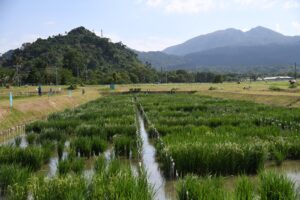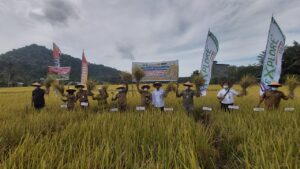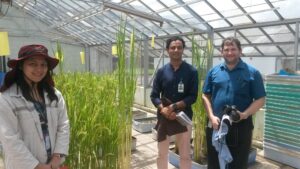The excitement of rice farmers in Saint-Louis, Senegal, upon seeing an appropriate engine-driven small-scale thresher from Asia in the mid-1990s could not have been far different from that of the first American president, George Washington, in 1796, when he was expecting the first horse-powered threshing machine to arrive from London. He described the new machine as one of “the most valuable institutions in this country; for nothing is more wanting and to be wished for on our farms.”
The Asian rice thresher, which the Senegalese rice farmers appreciated, was sent by the International Rice Research Institute (IRRI) upon request by the Africa Rice Center (AfricaRice). It was expected that this thresher could be locally manufactured and mounted to serve as an alternative to manual threshing.
The making of ASI
Thanks to an innovative partnership forged between national and international research and extension organizations, local artisans, farmers’ organizations, and the private sector, an improved rice thresher for the Senegal River Valley (the principal zone for irrigated rice in the country) was soon developed. Based on the IRRI prototype, it can reduce the drudgery associated with hand threshing and improve yield and marketability of rice.
Substantial modifications were made to the original thresher, including doubling its capacity, making it more robust by using sturdier material, increasing its processing power, and adding two wheels to make it a four-wheel version.
Named “ASI” after the three main partners—AfricaRice, the Senegal River Valley National Development Agency (SAED), and the Senegalese Institute of Agricultural Research (ISRA)—the thresher went through several adaptations to ensure that it met the requirements of producers and women rice farmers engaged in threshing activities.
ASI was commercially released in Senegal in 1997. Since then, ASI has become the most widely adopted thresher in Senegal, with major impact on the rice production chain.
A study showed that, with six workers, ASI yields six tons of paddy per day vis-á-vis one ton by manual threshing and four tons by Votex, the alternative small-scale thresher that was available in the Senegal River Valley. Moreover, with a grain-straw separation rate of 99%, no additional labor is required for sifting and winnowing compared to Votex, which could not properly separate grains from straw after threshing.
In other words, it reduces labor requirements, freeing up family members, particularly women, for other useful tasks; speeds up the postharvest process; allows the production of a higher quality product with a lower risk of damage; and increases the marketability of local rice in the face of imports.
Recognizing its immense value for the country as a technical solution that is acceptable to everyone in the rice-growing community, including women, the Grand Prix du Président de la République du Sénégal pour les Sciences (Special Prize of the President of Senegal for Scientific Research) was conferred in 2003 on the ASI thresher team. The team included AfricaRice Deputy Director General Marco Wopereis, who had served as an agronomist in the Saint- Louis Station of AfricaRice in the ’90s and was closely involved in all the stages of ASI’s development.
An impact study conducted by AfricaRice in Senegal 12 years later in 2009 showed that ASI continued to be one of the most important improved postharvest technologies in the Senegal River Valley, helping irrigated rice farmers to cope with labor scarcity. For farmers, the ASI thresher is a time- and labor-saving device with a high grain recovery rate.
Spreading across the region
As ASI’s popularity grew among the rice farming community and its impact continued to ripple outward and change the lives of rural households, the experience in Senegal was successfully extended to several West African countries (Côte d’Ivoire, Burkina Faso, Ghana, Mali, Mauritania, etc.), where each country further adapted the machine to suit its own specific conditions and released it under different brands.
ASI has recently spread to Central African countries Cameroon and Chad. Here, the local artisans, who were trained by AfricaRice and partners, were inspired to develop a series of modified prototypes for various crops. In 2011, the Chad government gave ASI high praise at the country’s 50th-anniversary celebration, where local ASI models were publicly displayed.
Why ASI clicked
Labor is a serious concern in sub- Saharan African agriculture since many labor-intensive tasks in crop production are carried out manually. For example, rice threshing and cleaning are manually carried out predominantly by women, who spend hours on these back-breaking operations. This not only affects their health but also the grain quality and profitability of rice.
Field surveys carried out in the ’90s in the Senegal River Valley revealed that the lack of improved practices and machinery resulted in postharvest rice crop losses of up to 35% and poor grain quality due to inefficient manual threshing.
The surveys also revealed other constraints, such as the frequent shortage of labor during rice harvest and postharvest periods and the unsuitability of existing systems that were too costly, time-consuming, or labor-intensive during peak labor demand. Consequently, paddy may sit in the field for weeks or even months waiting to be harvested or threshed; quality then deteriorates because of exposure to the elements and shattering.
Therefore, in response to the demand from rice stakeholders, AfricaRice decided to adapt and introduce ASI in the region by creating a coalition of partners.
The partnership model made the technology relevant. AfricaRice is now using this model to forge a new partnership and alliance to further develop rice harvest and postharvest technologies in sub-Saharan Africa.
Now, the Center is introducing and adapting a small affordable combine harvester in the Senegal River Valley for timely harvesting and threshing. The adapted prototype combine harvester, which is under tests, not only harvests small farm plots more quickly but also provides threshed and bagged grain of high quality, making it more attractive to local traders.
Given the examples of ASI and the mini-combine harvester introduced by AfricaRice and its partners, a number of rice stakeholders from sub-Saharan Africa who met in July 2011 to develop a road map for sustainable mechanization of the rice sector emphasized the value of small-scale, locally adapted machinery specifically targeting labor-intensive activities.
They also recommended that governments consult research when importing machinery to ensure its efficacy and durability under African farming conditions, and that capacity be built to provide after-sales support for farm machinery. Thus, the ripples created by ASI continue to expand.
___________________
Ms. Mohapatra is the head of Marketing and Communications at AfricaRice









